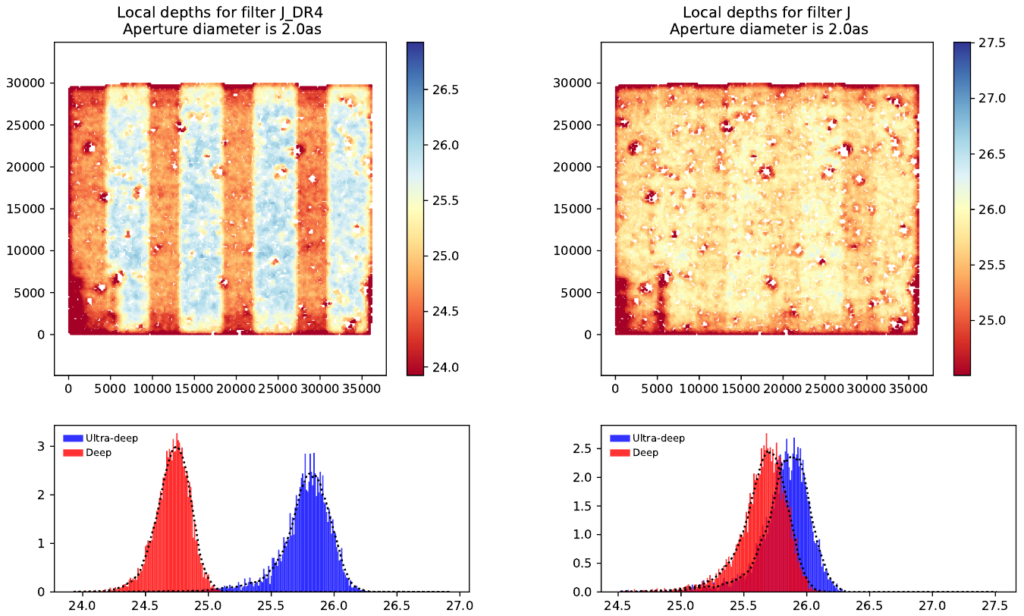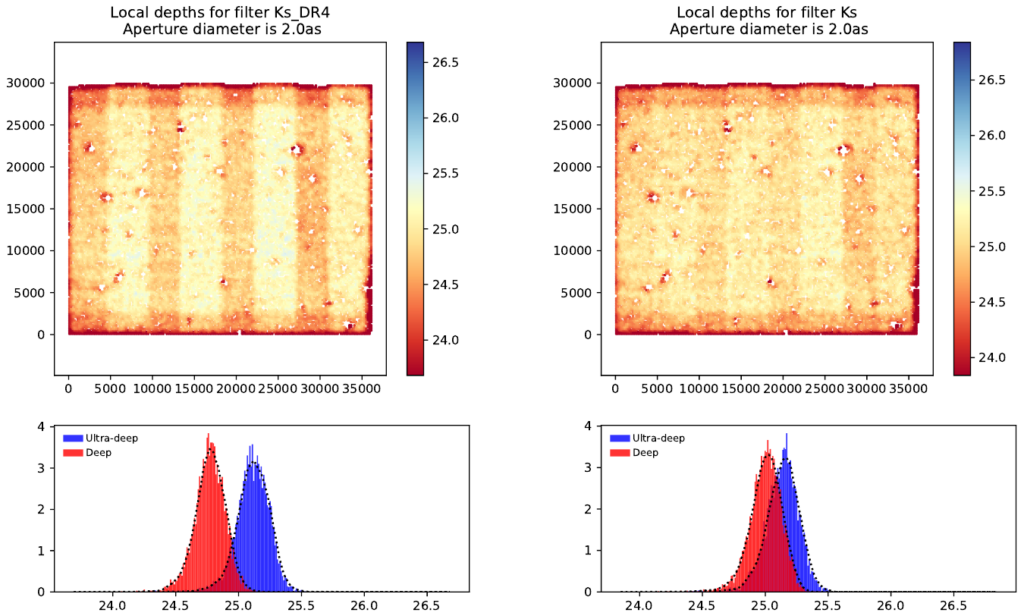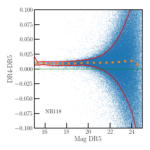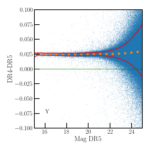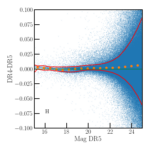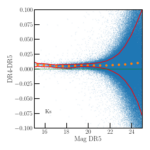The UltraVISTA DR5 RC1 is being made available for testing by the UltraVISTA consortium. If no issues are found, this data will be made public worldwide through the ESO phase 3 portal before the end of the year.
UltraVISTA is a deep survey of the COSMOS field using the VIRCAM camera on ESO’s VISTA telescope.
UltraVISTA Data Release 5 (DR5) comprises data taken for the UltraVISTA program at VISTA between December 2009 and May 2019. After rejection of bad images, 81,125 images were used to produce the release. As previously, data was reprocessed from the individual images delivered by CASU. A new sky subtraction was computed by masking objects using the DR4 stacks. The figure below shows the distribution of PSF and stellar ellipticity measured on each of the input images using PSFex. As in previous releases, images with a FHWM larger than 1″ or stellar ellipticity larger than 0.1 are discarded (these limits are indicated in the Figure by the dotted line).
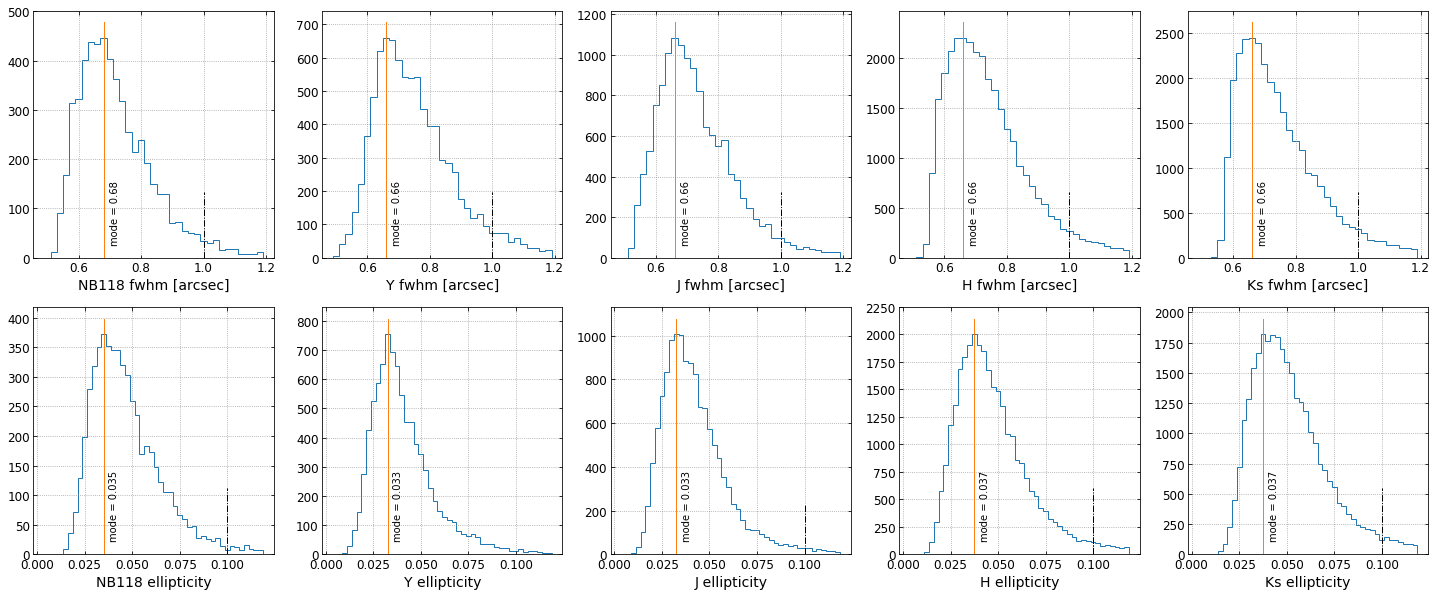
FWHM (top row) and Ellipticity (bottom row) distributions for all DR5 images for NB118,Y, J, H, Ks bands
The principal improvement compared to DR4 is that survey is now much deeper data in J and H over the full mosaic, a consequence of the much greater exposure time in the deep stripes. This can be seen in the table below, which gives the exposure time per pixel in DR4 and DR5.
[table id=1/]
Data access
For now, data are being distributed through a server at IAP; details of access have been communicated with UltraVISTA consortium members. The data will be made public once testing has been completed and it is ingested at ESO’s Phase 3 system.
Contents of the release
This release comprises five stacks and their corresponding weight maps in YJHKs and NB118 narrow band. Each image has a magnitude zero point (normalised to one second) of 30.0 AB magnitudes. For the conversion between AB magnitudes and VEGA we adopted the conversion factors in McCracken et al. (2012). As in previous releases, each image is aligned with the COSMOS tangent point and has a pixel scale of 0.15”/pixel and a size of 48906 times 48906 pixels.
Data processing
We use an identical version of the DR4 processing pipeline to process the 81,125 images which make up UltraVISTA DR5. As before, we use a double-pass (in this case actually a triple-pass) sky subtraction technique in which an object mask is created from a stack of all data in each band. This is used to mask all objects present in the individual images to create a sky image which can then be subtracted from each individual image. After several additional processing steps the end result is a stacked image which is extremely flat and a background which is almost completely free of artefacts.
Histograms of the seeing and ellipticity distributions for all input images are shown above. Data are discarded (i.e., not used to make the final stack) if the seeing or input ellipticity (measured on stellar sources) are larger than 1″ and 0.1 respectively.
Limiting magnitudes
We computed 5-sigma noise limits in 2″ apertures over each of the five stacked images in DR5 and compared with previous measurements in DR4. This is shown in the series of figures below (click for larger versions). In DR5, J, H bands have now similar depths between deep and ultra-deep stripes, thanks to the greatly increased integration times in these regions in DR5.
Astrometric precision
Astrometric solutions have been recomputed for all images using Gaia EDR3. The astrometric precision is excellent, with an RMS of around ~20 mas compared to the Gaia reference catalogue and internally (band-to-band).
Photometric precision
We compared photometry in each of five bands with previous UltraVISTA release (DR4) over the ultra-deep area (which has changed little since the previous release). The figure below shows the difference in 2″ aperture magnitudes between DR4 and DR5 against the DR5 “mag_auto” magnitudes. Photometric measurements are in very good agreement with previous releases.
Image quality
Using SExtractor catalogues extracted on each of the five stacks, we measured image quality using PSFex. As before, we find the FWHM on all stacks is ~ 0.75 +/-0.05″.
Caveats and warning
Release schedule
After a period of testing, this release will be distributed through ESO’s PHASE 3 system. A full release document will be distributed at this time.
DR5 data processing team
Many people contributed to the DR5 data processing effort.
Andrea Moneti: processing, pipeline development, data quality control;
Bo Milvang-Jensen, Rebecca Bowler, Derek McLeod, Callum Donnan: data quality control;
Jim Dunlop, Olivier Le Fèvre, Johan Fynbo, Marijn Franx: oversight;
S. Rouberol: infrastructure;
H. J. McCracken: coffee (and tea)
Acknowledgments
The computer cluster used to process the UltraVISTA DR5 dataset was created thanks to grants from the “Le Domaine d’Intérêt Majeur ACAV” and additional funding from French national program for cosmology and the CNES. We have made extensive use of the Astromatic software suite.
Acknowledging this work
Any work using UltraVISTA DR5 images should include a citation to McCracken et al. (2012) and the following text:
Based on observations collected at the European Southern Observatory under ESO programme ID 179.A-2005 and 198.A-2003 and on data products produced by CALET and the Cambridge Astronomy Survey Unit on behalf of the UltraVISTA consortium.



